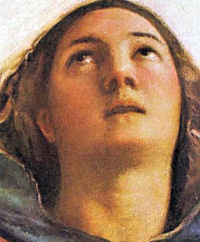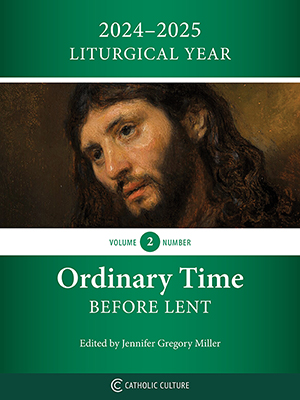Ordinary Time: August 15th
Solemnity of the Assumption
Other Commemorations: St. Tarcisius, Martyr (RM); St. Hyacinth of Poland, Priest (RM); St. Stanislaus Kostka (RM) ; Other Titles: Dormition of Our Lady (Eastern Rite)
» Enjoy our Liturgical Seasons series of e-books!
On November 1, 1950, Pius XII defined the dogma of the Assumption. Thus he solemnly proclaimed that the belief whereby the Blessed Virgin Mary, at the close of her earthly life, was taken up, body and soul, into the glory of heaven, definitively forms part of the deposit of faith, received from the Apostles. To avoid all that is uncertain the Pope did not state either the manner or the circumstances of time and place in which the Assumption took place — only the fact of the Assumption of Mary, body and soul, into the glory of heaven, is the matter of the definition.
Please see this special section on The Assumption.
Historically today is the feast of St. Tarcisius, a young martyr of the Eucharist.
The Assumption
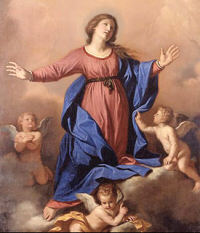 Now toward the end of the summer season, at a time when fruits are ripe in the gardens and fields, the Church celebrates the most glorious "harvest festival" in the Communion of Saints. Mary, the supremely blessed one among women, Mary, the most precious fruit which has ripened in the fields of God's kingdom, is today taken into the granary of heaven.
Now toward the end of the summer season, at a time when fruits are ripe in the gardens and fields, the Church celebrates the most glorious "harvest festival" in the Communion of Saints. Mary, the supremely blessed one among women, Mary, the most precious fruit which has ripened in the fields of God's kingdom, is today taken into the granary of heaven.
—Pius Parsch, The Church's Year of Grace
The Assumption is the oldest feast day of Our Lady, but we don't know how it first came to be celebrated.
Its origin is lost in those days when Jerusalem was restored as a sacred city, at the time of the Roman Emperor Constantine (c. 285-337). By then it had been a pagan city for two centuries, ever since Emperor Hadrian (76-138) had leveled it around the year 135 and rebuilt it as Aelia Capitolina in honor of Jupiter.
For 200 years, every memory of Jesus was obliterated from the city, and the sites made holy by His life, death and Resurrection became pagan temples.
After the building of the Church of the Holy Sepulchre in 336, the sacred sites began to be restored and memories of the life of Our Lord began to be celebrated by the people of Jerusalem. One of the memories about his mother centered around the "Tomb of Mary," close to Mount Zion, where the early Christian community had lived.
On the hill itself was the "Place of Dormition," the spot of Mary's "falling asleep," where she had died. The "Tomb of Mary" was where she was buried.
At this time, the "Memory of Mary" was being celebrated. Later it was to become our feast of the Assumption.
For a time, the "Memory of Mary" was marked only in Palestine, but then it was extended by the emperor to all the churches of the East. In the seventh century, it began to be celebrated in Rome under the title of the "Falling Asleep" ("Dormitio") of the Mother of God.
Soon the name was changed to the "Assumption of Mary," since there was more to the feast than her dying. It also proclaimed that she had been taken up, body and soul, into heaven.
That belief was ancient, dating back to the apostles themselves. What was clear from the beginning was that there were no relics of Mary to be venerated, and that an empty tomb stood on the edge of Jerusalem near the site of her death. That location also soon became a place of pilgrimage. (Today, the Benedictine Abbey of the Dormition of Mary stands on the spot.)
At the Council of Chalcedon in 451, when bishops from throughout the Mediterranean world gathered in Constantinople, Emperor Marcian asked the Patriarch of Jerusalem to bring the relics of Mary to Constantinople to be enshrined in the capitol. The patriarch explained to the emperor that there were no relics of Mary in Jerusalem, that "Mary had died in the presence of the apostles; but her tomb, when opened later . . . was found empty and so the apostles concluded that the body was taken up into heaven."
In the eighth century, St. John Damascene was known for giving sermons at the holy places in Jerusalem. At the Tomb of Mary, he expressed the belief of the Church on the meaning of the feast: "Although the body was duly buried, it did not remain in the state of death, neither was it dissolved by decay. . . . You were transferred to your heavenly home, O Lady, Queen and Mother of God in truth."
All the feast days of Mary mark the great mysteries of her life and her part in the work of redemption. The central mystery of her life and person is her divine motherhood, celebrated both at Christmas and a week later (Jan. 1) on the feast of the Solemnity of Mary, Mother of God. The Immaculate Conception (Dec. 8) marks the preparation for that motherhood, so that she had the fullness of grace from the first moment of her existence, completely untouched by sin. Her whole being throbbed with divine life from the very beginning, readying her for the exalted role of mother of the Savior.
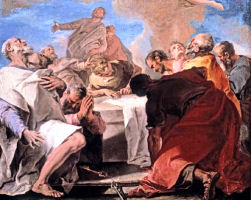 The Assumption completes God's work in her since it was not fitting that the flesh that had given life to God himself should ever undergo corruption. The Assumption is God's crowning of His work as Mary ends her earthly life and enters eternity. The feast turns our eyes in that direction, where we will follow when our earthly life is over.
The Assumption completes God's work in her since it was not fitting that the flesh that had given life to God himself should ever undergo corruption. The Assumption is God's crowning of His work as Mary ends her earthly life and enters eternity. The feast turns our eyes in that direction, where we will follow when our earthly life is over.
The feast days of the Church are not just the commemoration of historical events; they do not look only to the past. They look to the present and to the future and give us an insight into our own relationship with God. The Assumption looks to eternity and gives us hope that we, too, will follow Our Lady when our life is ended.
In 1950, in the Apostolic Constitution Munificentissimus Deus, Pope Pius XII proclaimed the Assumption of Mary a dogma of the Catholic Church in these words: "The Immaculate Mother of God, the ever-virgin Mary, having completed the course of her earthly life, was assumed body and soul into heaven."
With that, an ancient belief became Catholic doctrine and the Assumption was declared a truth revealed by God.
—Excerpted from Fr. Clifford Stevens in Catholic Heritage
Patronage: fish dealers; fishmongers; French air crews (proclaimed in 1952); harness makers; France (proclaimed in 1922); Guatemala; India; Jamaica (proclaimed in 1951); Malta; Paraguay (proclaimed in 1951); Slovakia; Acadians; Cajuns; east Africa (proclaimed on 15 March 1952 by Pope Pius XII); south Africa (proclaimed on 15 March 1952 by Pope Pius XII); Maryland, USA; Cistercian Order; Cistercians; Catholic Action in Italy. See CatholicSaints.info for a full list.
Highlights and Things to Do:
- Read more about the Assumption:
- Listen to the Catholic Culture audiobook of St. John Newman On the Fitness of the Glories of Mary read by James Majewski.
- The Directory on Popular Piety talks about the deep significance of this feast day. It also refers to the custom of blessing herbs:
In the Germanic countries, the custom of blessing herbs is associated with 15 August. This custom, received into the Rituale Romanum, represents a clear example of the genuine evangelization of pre-Christian rites and beliefs: one must turn to God, through whose word "the earth produced vegetation: plants bearing seeds in their several kinds, and trees bearing fruit with their seed inside in their several kinds" (Gen 1, 12) in order to obtain what was formerly obtained by magic rites; to stem the damages deriving from poisonous herbs, and benefit from the efficacy of curative herbs.
This ancient use came to be associated with the Blessed Virgin Mary, in part because of the biblical images applied to her such as vine, lavender, cypress and lily, partly from seeing her in terms of a sweet smelling flower because of her virtue, and most of all because of Isaiah 11, 1, and his reference to the "shoot springing from the side of Jesse", which would bear the blessed fruit of Jesus.
This older form of a Blessing of Herbs is included in the prayers library.
- In an age of sensuality and materialism the Assumption points out the dignity and destiny of our human body, extols the dignity of womanhood, and turns our eyes to the true life beyond the grave. At Mass today ask Mary for the grace to keep your mind fixed on things above and to aspire continually to be united with her and to be brought to the glory of the Resurrection.
- Read Father Francis Weiser's Customs and Traditions of the Solemnity of the Assumption, August 15.
- Artists have loved to depict the Assumption of Mary. See Fine Art America for a nice collection of different paintings.
- There are many recipe and activity suggestions in the Activities and Recipes sections. Consider serving "first fruits" for the feast day. See also Catholic Cuisine for further inspiration.
St. Tarcisius
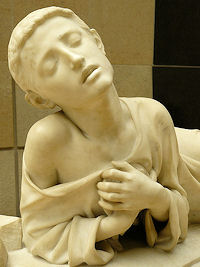 Tarcisius was a twelve-year-old acolyte during one of the fierce Roman persecutions of the third century, probably during that of Valerian. Each day, from a secret meeting place in the catacombs where Christians gathered for Mass, a deacon would be sent to the prisons to carry the Eucharist to those Christians condemned to die. At one point, there was no deacon to send and so St. Tarcisius, an acolyte, was sent carrying the "Holy Mysteries" to those in prison.
Tarcisius was a twelve-year-old acolyte during one of the fierce Roman persecutions of the third century, probably during that of Valerian. Each day, from a secret meeting place in the catacombs where Christians gathered for Mass, a deacon would be sent to the prisons to carry the Eucharist to those Christians condemned to die. At one point, there was no deacon to send and so St. Tarcisius, an acolyte, was sent carrying the "Holy Mysteries" to those in prison.
On the way, he was stopped by boys his own age who were not Christians but knew him as a playmate and lover of games. He was asked to join their games, but this time he refused and the crowd of boys noticed that he was carrying something. Somehow, he was also recognized as a Christian, and the small gang of boys, anxious to view the Christian "Mysteries," became a mob and turned upon Tarcisius with fury. He went down under the blows, and it is believed that a fellow Christian drove off the mob and rescued the young acolyte.
The mangled body of Tarcisius was carried back to the catacombs, but the boy died on the way from his injuries. He was buried in the cemetery of St. Callistus, and his relics are claimed by the church of San Silvestro in Capite.
In the fourth century, Pope St. Damasus wrote a poem about this "boy-martyr of the Eucharist" and says that, like another St. Stephen, he suffered a violent death at the hands of a mob rather than give up the Sacred Body to "raging dogs." His story became well known when Cardinal Wiseman made it a part of his novel Fabiola, in which the story of the young acolyte is dramatized and a very moving account given of his martyrdom and death.
Tarcisius, one of the patron saints of altar boys, has always been an example of youthful courage and devotion, and his story was one that was told again and again to urge others to a like heroism in suffering for their faith. In the Passion of Pope Stephen, written in the sixth century, Tarcisius is said to be an acolyte of the pope himself and, if so, this explains the great veneration in which he was held and the reason why he was chosen for so difficult a mission.
—Excerpted from The One Year Book of Saints by Rev. Clifford Stevens
Patronage: acolytes; altar servers; First Communicants
Highlights and Things to Do:
- Read more about St. Tarcisius:
- Read Pope Benedict XVI's General Audience on St. Tarcisius.
- See St. Tarcisius—Martyr of the Eucharist.
- Read St. Tarcisius: Protector of the Hidden Jesus.
- St. Tarcisius is portrayed in the book, Fabiola by Nicholas Cardinal Wiseman, first published in 1854.
St. Hyacinth of Poland
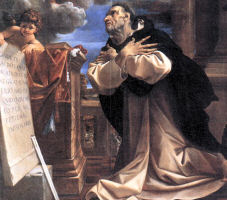 While a canon at the cathedral of Cracow, Hyacinth journeyed to Rome, was impressed by the preaching and miracles of St. Dominic, and from the hand of Dominic himself received the habit of the newly-founded Order. Upon returning to his native land (1219), he established monasteries of his Order beyond the Alps at Friesach, Prague, Olmiitz, and Cracow.
While a canon at the cathedral of Cracow, Hyacinth journeyed to Rome, was impressed by the preaching and miracles of St. Dominic, and from the hand of Dominic himself received the habit of the newly-founded Order. Upon returning to his native land (1219), he established monasteries of his Order beyond the Alps at Friesach, Prague, Olmiitz, and Cracow.
From the Breviary we have this miracle. With three companions Hyacinth had arrived at the banks of the river Weichsel during their journey to Vischegrad, where they were expected to preach. But the waters had risen so high and had become so violent that no ferryman dared to cross. The saint took his mantle, spread it out before him, and with his companions rode across the raging waters. After saying his Office for the day, he died in 1257 with these words on his lips: "Into Your hands, Lord, I rest my spirit!"
—Excerpted from The Church's Year of Grace, Pius Parsch
Patronage: Poland; against drowning; weightlifting; Camalaniugan, Philippines; Ermita de Piedra de San Jacinto, Tuguegarao, Philippines; archdiocese of Krakow, Poland; Lithuania (named by Pope Innocent XI in 1686);
Symbols and Representation: Pyx; staff; cloak; scorpion
Highlights and Things to Do:
- The Church's night prayer, Compline, especially the closing invocations, serves as a fitting preparation for death. The two death scenes strike home with telling impact. 1) Christ, hanging on the Cross, is uttering His last word: "Father, into Your hands I commend My spirit." Meditatively we repeat the words and entrust our souls to the care of Christ in sleep, and if need be, in death. For Hyacinth it actually was his dying invocation. 2) The second scene, the aged Simeon is singing: "Now You may dismiss Your servant in peace." How appropriate as one's last day approaches!
- See this Dominican site for an excerpt from the Life of Saint Hyacinth.
- Read how pierogi is a food associated with St. Hyacinth.
- Read more about St. Hyacinth:
- Vist Christian Iconography to see some images of St. Hyacinth.
- See the statue of St. Hyacinth on St. Peter's Basilica Colonnade.
St. Stanislaus Kostka
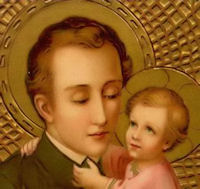 The son of a Polish senator, St. Stanislaus was first privately educated at the family castle. He later attended the Jesuit college in Vienna, where he set a holy example for all. While at the college, Stanislaus suffered from a serious illness. St. Barbara and two angels appeared to him and he seemed to be given Holy Communion in the vision (either by St. Barbara or by the angels). Also, Our Lady visited him and told him that he would recover and become a Jesuit. The Jesuit provincial in Vienna was too afraid of making Stanislaus's father angry to admit Stanislaus to the Order, so the saint walked to Augsburg and then Dillingen, a total of 350 miles, and there appealed to St. Peter Canisius, the Jesuit provincial of Upper Germany. St. Peter Canisius took him in, and after three weeks, sent Stanislaus to Rome to see St. Francis Borgia, who was general of the Jesuits. In Rome, Stanislaus became a Jesuit at the age of 17, much to the dissatisfaction of his father. His devotion to the Eucharist was apparent to all, since he went into ecstasy after receiving Communion. St. Stanislaus became ill again and died only nine months into his novitiate.
The son of a Polish senator, St. Stanislaus was first privately educated at the family castle. He later attended the Jesuit college in Vienna, where he set a holy example for all. While at the college, Stanislaus suffered from a serious illness. St. Barbara and two angels appeared to him and he seemed to be given Holy Communion in the vision (either by St. Barbara or by the angels). Also, Our Lady visited him and told him that he would recover and become a Jesuit. The Jesuit provincial in Vienna was too afraid of making Stanislaus's father angry to admit Stanislaus to the Order, so the saint walked to Augsburg and then Dillingen, a total of 350 miles, and there appealed to St. Peter Canisius, the Jesuit provincial of Upper Germany. St. Peter Canisius took him in, and after three weeks, sent Stanislaus to Rome to see St. Francis Borgia, who was general of the Jesuits. In Rome, Stanislaus became a Jesuit at the age of 17, much to the dissatisfaction of his father. His devotion to the Eucharist was apparent to all, since he went into ecstasy after receiving Communion. St. Stanislaus became ill again and died only nine months into his novitiate.
Patronage: against broken bones; aspirants to the Oblates of Saint Joseph; desperate, lost or impossible causes; last sacraments; Metropolitan Seminary in Lublin, Poland; Poland
Symbols and Representation: Holy Communion; young man holding the Christ child
Highlights and Things to Do:
- Learn more about St. Stanislaus Kostka:
- Read more about St. Stanislaus Kostka and find additional prayers here.
- At St. Stanislaus Kostka Polish Catholic Parish read about the Patron Saint of Holy Disobedience.
- Read the Message of the Holy Father Francis for the 450th Anniversary of the Death of St. Stanislaus Kostka.


